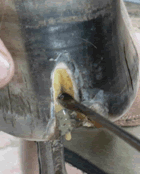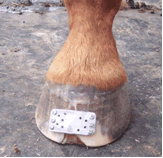 Seedy toe (also known as white line disease) is the invasion and subsequent destruction and consumption of the inner hoof wall keraton by various species of fungi or bacteria or a symbiosis of both species.
Seedy toe (also known as white line disease) is the invasion and subsequent destruction and consumption of the inner hoof wall keraton by various species of fungi or bacteria or a symbiosis of both species.
It has the appearance of black paste or crumbly grey/white cheese. The resultant cavity is often jammed with grass seeds - hence the name.
This scenario sets up a fundamental weakness that affects the integrity of the entire hoof capsule.
 Short term effects:
Short term effects:
Seedy toe breaks the integrity of the hoof capsule, often resulting in a vertical crack that travels up the hoof wall in tandem with the spread of the pathogens. If left untreated, such cracks may ultimately travel as far as the coronary band, thus making it a permanent defect.
Seedy toe may also cause lameness by forming an abscess.
 Long term effects:
Long term effects:
Seedy toe can be more sinister in the long term if left untreated. Not only can it leave scar tissue in the dermal laminae which becomes a permanent weakness in the hoof capsule's integrity, but the pathogens can penetrate the dermal layer and ultimately affect the pedal bone itself, leading to bone infection and bone erosion. (picture, normal and eaten away).
Prevention
Preventing seedy toe is all about not giving the pathogens a chance to penetrate the fortress of the hoof capsule; in other words maintaining the integrity and strength of the lamellar line by:
- maintaining the length of the hoof wall so that hoof cracks are not created through mechanical forces.
- maintaining the health of the laminar line by preventing laminitis.
- providing relief from wet environments
Treatment
Seedy toe should be treated as soon as a breach of hoof wall integrity is noticed. In damp environments it is wise to attend to black cracks as soon as they appear.
The first step is to trim with a more aggressive roll on the outer wall to remove any mechanical forces. This may be enough for the infected wall to grow out.
If the seedy toe fails to show significant improvement after two or three trim cycles, it will need to be resected and killed. It is very important to remove all of the pathogen, which means resecting beyond the visible seedy toe and a small way into the healthy inner wall to ensure removal of penetrating spores.
It is very impoprtant to augment the integrity of the hoof capsule when a major part of the wall has been resected.
If the resection goes beyond about half way up the hoof wall, a stabilizing patch should probably be used.
Once resected, there is the need for topical treatment to kill any remaining ‘bugs’. There is an endless possibility of treating agents, the important thing is to use something that is strong enough to kill the pathogens, but not strong so that the dermal layer is damaged. Initially a hydrogen peroxide solution is good to clean the cavity with as the pathogens are generally anaerobic. For topical treatment it is best to use an agent that is effective against fungus and bacteria ie Ti tree oil, diluted bleach or iodine. However, a mixture using copper sulphate (fungicide) and Vaseline has been commonly used. We have had tremendous success with Black Healer which is available in our online shop.
It is important to treat every day for a week and probably about once a week after that until the cavity has grown out, to ensure that any fresh arrivals of pathogens are killed off.
In severe cases, the best way to access the seat of infection is by “keyholing” – drilling into the wall which maintains a bridge across the lower wall. Treatment of seedy toe is a job for professional trimmers who know the anatomial boundaries
Seedy toe is an inconvenience for both trimmer and horse owner, but it should not be ignored.



